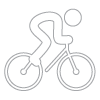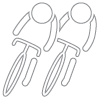Clubs runs are meant to be an enjoyable and sociable experience. Your enjoyment will be enhanced by following some simple rules on how to ride in a group:
- Riders must wear helmets when taking part in any SWRC activity.
- Where road and traffic conditions allow, riders should arrange themselves in twos, following closely the pair in front. Your ride leader should ensure that the group is no larger than 10 riders.
- Where the road is narrow or traffic is heavy, the group should form into a single file. Please listen for the group leader calling 'single out' and move into single file promptly on hearing this.
- Not pushing into the peloton when no room exists forcing the rider behind to slow down.
- When overtaking on the right give plenty of room and maybe say 'on your right', never on the inside.
- As you become more experienced, take your turn at riding on the front of the group, moving over to let others take over after a reasonable length of time. The more experienced riders will be able to tell you how long that should be depending on circumstances such as the size of the group and the weather conditions.
- When riding on the front, try not to break away from the group. If you are trying to increase the pace, try to make sure that the next rider or pair is following. If you find you are breaking away, slacken the pace a little until the group is together and then try to increase the pace more gradually. Remember, if you get ahead of the group and go the wrong way it’s your own fault and you may need to find your own way home. If you are finding the pace, either too slow or too fast, you will need to consider joining a different group on your next outing.
- The group can tend to break up when riding up a climb. When this happens, riders should stop at the top to allow the ride to re-group.
- Take responsibility for the rider behind you. If someone is lagging or missing off the back of the group, report it to the ride leader promptly.
- If someone near you has a puncture or other mechanical problem, call out to the group. It is usual for the group to wait together until the problem has been fixed.
- If you feel you need to ride on because of time pressures, make sure you clear this with the group leader first.
- Take time to learn the various hand signals that experienced riders use to point out road hazards such as potholes and parked cars.
- Make sure you use them when riding on the front. A shout of 'car up' from someone means that a vehicle is approaching from behind and the group needs to modify its riding to take account of this. Similarly, a shout of 'car down', means that a vehicle is approaching from in front.
- Communication: Let other riders know your intention. i.e. if looking behind just say pulling out and check to see if another rider is behind you before you make the action, communicate in the peloton. So, others know. i.e. slowing, etc.
- Try not half wheeling from behind.
- Make sure your bike is regularly serviced and is in good working order as far as you can tell at the start of the ride.
- You will find it helpful to become proficient in undertaking a few basic mechanical repairs. As a beginner you will not be expected to have much skill in this area and watching how more experienced riders do these things is the best way to learn. As soon as possible, you should at least become proficient in changing a punctured inner tube.
- Make sure you carry, either in your pocket or saddle wedge, tyre levers, at least one spare tube and a pump or CO2 cylinders. Most rides also carry a multi-tool or alternatively a few Allen keys and a Philips Head screwdriver.
- In winter when the lanes are muddy, you should ride with mudguards. If you turn up on a wet and muddy day without mudguards, you may be asked to stay at the back for the duration of the ride.
This may seem like an extensive list of rules, but they are really not too onerous and if we all stick to them, they will really enhance our enjoyment.
For your own personal comfort, you should also dress appropriately for the weather especially in winter. Most of us find that several layers are more effective than one thick garment. Cold hands and feet can be especially unpleasant particularly in the wet and so good winter gloves and overshoes are a really good investment to make. A good pair of winter tights are a very useful addition to the cycling wardrobe and most of us carry a waterproof jacket of some sort.
Bike rides take place over a longer time period than many other sporting events. Most of us like to ensure that we have a good breakfast before we start and will usually carry a few items of energy rich food with us on the ride such as bananas, jelly babies, energy gels and bars. It is also important to stay hydrated and so make sure carry enough fluid on your bike and that you drink at regular intervals throughout.
More to read and watch here…






